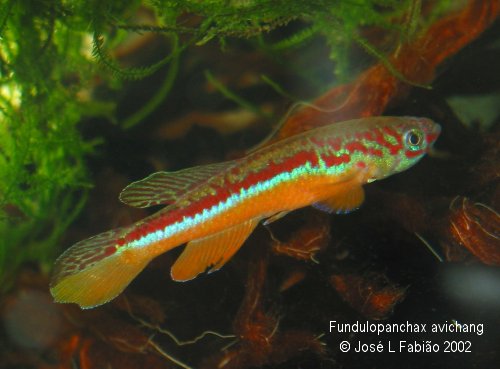
Fundulopanchax avichang F.Malumbres & R.Castelo 2001

Fp.avichang
GEML 00 / 16 Nguba II.
Photo courtesy of José L Fabião (Filipe Torres).
| Meaning of Name |
|
| First Description |
Malumbres F.& Castelo R. 2001 Description of a new Species belonging to the Genus Fundulopanchax MYERS,1924(Cyprinodontiformes, Aplocheilidae), of the continental Ichthyofauna of Ecuatorial Guinea. La Ictiofauna continental
de Guinea Ecuatorial. Graellsia , 57 (2): Holotype: One male with the number MNCN (1) 219.341
with a standard length of 25.52 mm. Seasonal pool located inside the
hydrographic basin of the Ecucu River, Nguba II (Bata, Ecuatorial Guinea).
N 1º 45,651'E 9º 49,443'N. 42 meters of altitude. |
| Size |
40 mm. Tank housed specimens have been reported at 6 cm for a male & 5 cm for a female. |
| Meristics |
ll = 29-31. |
| Karyotype |
|
| Sub-Genus |
|
| Group |
|
| Synonyms |
|
|
Populations
|
GEMLB 02 / 1 is the same location as GEML 00/16 but was fished 14 months after the 2000 trip. The biotope was dry & no Fp.avichang were found. Water was found on the other side of the road but this was muddy & again no Fp.avichang were found. |
| Type Locality |
Nguba II (Bata). |
| Distribution |
Probably restricted to the coastal area of Bata, Equatorial Guinea. |
| Habitat |
Small temporary pools of the River Ecucu drainage. |
| Distinguishing Characteristics | Apart from the obvious colouration their are certain differences. The caudal fin has no filaments. This fin is also romboidal with a tip. The dorsal fin has no red line. The anal fin is yellow/orange without ray filaments or points. Size is also a distinguishing characteristic as they only grow to 40mm. |
| Colour/Pattern Variability | Probably low. |
| History |
17 specimens were collected at Ngabu II on the
GEML 2000 collecting trip. Some were placed in Ethonol 70% & placed
in Madrid's Natural Science National History Museum of Ichthyology (Museo
Nacional de Ciencias Naturales de Madrid). |
| Breeding Notes |
Preliminary reports suggest this sp. to be non
productive, laying few eggs in peat. They were reported not to lay in
Java moss. |
| Diameter of Egg | |
| Remarks |
|